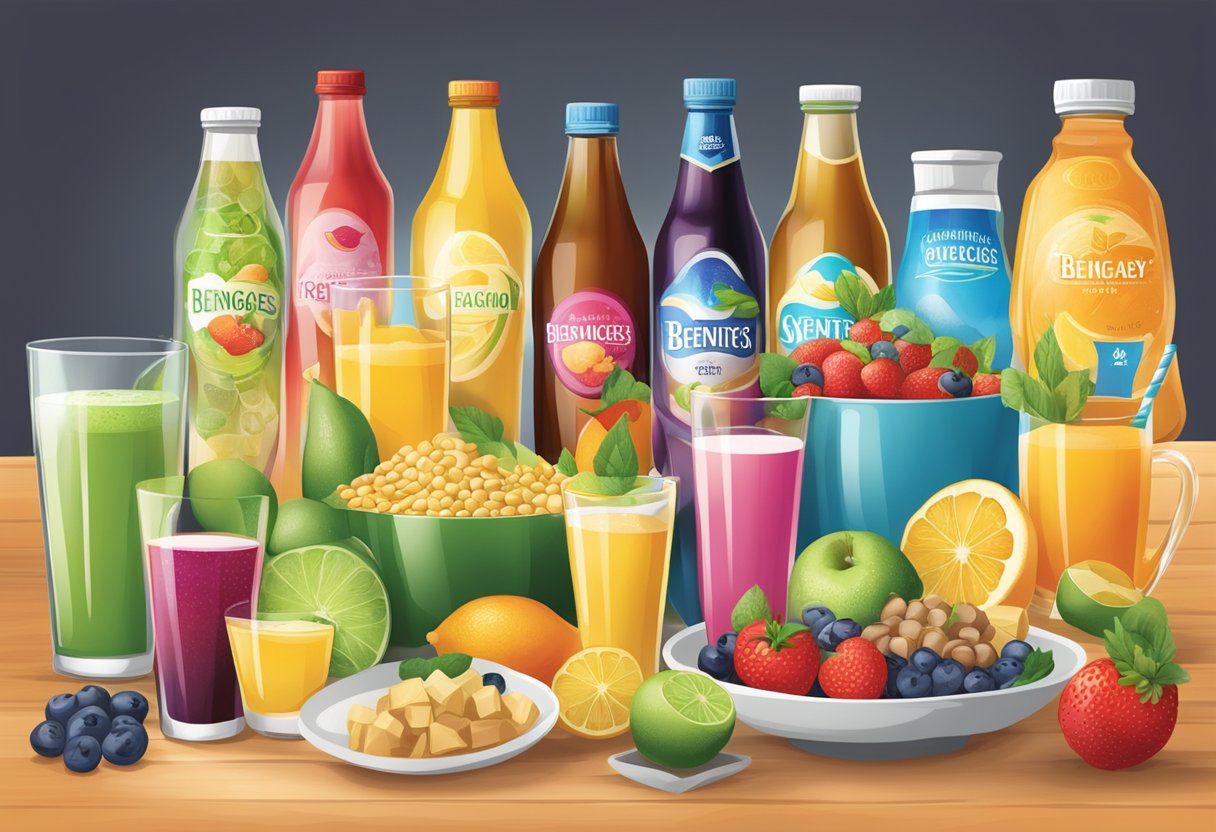As we navigate through the early months of 2024, the food and nutrition landscapes continue to evolve rapidly, reflecting a synthesis of scientific research, environmental concerns, and shifting consumer preferences.
A major trend we see this year is a heightened interest in functional and fortified foods which offer additional health benefits beyond basic nutrition. Products such as snacks infused with vitamins or energy-boosting ingredients are gaining popularity as consumers look for more ways to enhance wellness through their diet.

On the beverage front, there is a clear trend toward options that not only quench thirst but also contribute to overall health. Drinks that support gut health with probiotics or provide a calmative effect with botanical additives exemplify the movement toward beverages with benefits. Additionally, sustainability remains a persistent theme, with more individuals opting for foods that are ethically sourced and produced within regenerative agricultural systems. This is a reflection of growing consumer awareness of the environmental impact of food production and a desire to make responsible choices that align with personal values and the wellbeing of the planet.
Key Takeaways
- Functional foods with added health benefits are more sought after.
- Beverages are increasingly designed to support overall health.
- Sustainability and ethical sourcing in food production are vital to consumers.
Emergent Ingredients and Nutrients

The year 2024 continues to witness the rise of health-conscious consumers seeking alternative ingredients that offer both nutritional benefits and sustainability. Within this landscape, several key categories of ingredients and nutrients have emerged.
Plant-Based Proteins
Plant-based proteins are capturing the attention of consumers and food manufacturers alike. Proteins derived from peas and rice have become popular due to their complete amino acid profiles and lower environmental impact compared to animal-based proteins. These sources cater to a diverse array of diets, including vegan and vegetarian lifestyles, while providing essential nutrients.
Functional Fibers and Prebiotics
An increased focus on digestive health has highlighted the importance of functional fibers and prebiotics. Ingredients such as chicory root and inulin not only offer the benefits of dietary fiber but also act as prebiotics, feeding beneficial gut bacteria and contributing to overall health.
Diversified Dairy Alternatives
The demand for dairy alternatives has expanded beyond soy and almond to include options like oat milk. Oat milk in particular is gaining traction due to its creamy texture, environmental benefits, and hypoallergenic properties. These alternatives are increasingly fortified with calcium and vitamins to match the nutritional profile of traditional dairy.
Innovative Sweeteners and Sugar Alternatives
With a growing interest in reducing sugar intake, innovative sweeteners have emerged. These alternatives seek to provide the sweetness consumers desire without the adverse effects of high sugar consumption. Sweeteners derived from natural sources like stevia or made through fermentation processes are on the rise. They cater to those looking for lower-calorie or lower-glycemic index options without compromising taste.
Dietary Patterns and Eating Habits

In 2024, dietary trends emphasize nutritious whole foods and plant-based diets, reflecting a global fusion of flavors and a growing attention to eating patterns that promote health and sustainability.
Rise of Whole Foods and Clean Eating
Consumers are prioritizing whole foods such as fruits, vegetables, beans, and nuts, valuing the inherent nutrients and fiber they offer. Clean eating has become synonymous with consuming foods in their most natural state, minimizing processed ingredients. This shift underscores the importance of nutritional quality, as people are focused on foods that deliver essential vitamins and minerals like iron and calcium without added sugars or preservatives.
- Whole Foods Favored: Fruits, vegetables, whole grains, legumes.
- Clean Eating Principles: Unprocessed, organic, no artificial additives.
Plant-Based Diet Evolution
The plant-based diet has evolved, moving from a niche interest to a mainstream choice. There’s an emphasis on diversifying intake with a variety of vegetables, beans, and healthful fats like those found in nuts, olives, and avocados. This dietary pattern has been recognized for its potential to supply all necessary nutrients, including calcium from sources like fortified plant milks, and iron from legumes and leafy greens.
- Plant-Based Sources of Calcium: Soy milk, almond milk, calcium-fortified beverages.
- Iron-Rich Plant Foods: Lentils, chickpeas, spinach, and kale.
Global Influence: Third-Culture Cuisine
Globalization has significantly influenced dietary patterns, leading to the rise of third-culture cuisine—a blend of various culinary traditions creating new hybrid dishes. Ingredients typical of the Mediterranean diet, such as olive oil and seafood, are combined with flavors and techniques from other cultures, resulting in a celebration of diversity on the plate. This cross-cultural exchange not only enriches the dining experience but also encourages the exploration of new foods and nutrients.
- Examples of Third-Culture Dishes: Fusion bowls, taco samosas, kimchi burritos.
- Key Mediterranean Ingredients: Olive oil, legumes, whole grains, fish.
Consumer Health and Wellness Focus

In 2024, consumers increasingly prioritize holistic health approaches, integrating physical, mental, and emotional well-being into their dietary choices. They seek foods that not only nourish the body but also cater to mental clarity and stress management.
Mind-Body Connection: Mental and Emotional Health
Consumers are embracing foods and beverages that promote a positive mind-body connection. Advances in nutritional psychiatry have identified certain foods that can improve mental health and mood. For example, functional beverages enriched with adaptogens and nootropics are marketed for their potential to enhance focus and reduce stress. Consumption of omega-3 rich fish and vitamin D fortified foods has been linked to improved emotional health.
Women’s Health and Nutrition
For women’s health, there is a focus on nutrition that supports hormonal balance and overall well-being throughout the various stages of life. Iron-rich foods, calcium, and vitamin D play significant roles in women’s nutritional regimes. Additionally, plant-based diets are gaining traction among women seeking improved health outcomes and sustainability.
Kids and Adolescent Nutritional Needs
Proper nutrition is crucial for children and adolescents, as they require ample micronutrients for growth and cognitive development. Schools and parents are paying more attention to reducing sugar intake and providing balanced meals that contribute to sustained focus and wellness. There is also a push toward educating the young on the importance of quality sleep and its impact on their overall health.
Lifestyle Influences on Food and Nutrition

Lifestyle choices are increasingly shaping food and nutrition trends, with personal health goals and daily habits playing pivotal roles. People’s approach to dieting is driven by various factors that coalesce around fitness, aging, and overall wellness.
Fitness and Performance Nutrition
Individuals who are engaged in fitness routines tend to prioritize performance-enhancing nutrition, integrating high-protein food items, such as protein powder, to optimize their workouts and recovery. The trend towards functional beverages, particularly those that support energy levels and muscle recovery, is becoming evident. A Look at 2024 Nutrition Trends confirms the growing demand for nutrition that supports active lifestyles.
Aging Population Dietary Considerations
As the population ages, dietary needs shift, emphasizing nutrients that support longevity and chronic disease management. Crucial to this demographic are foods high in healthy fats and low in calories, aiding in the maintenance of heart health and cognitive function. There is an observed increase in the consumption of omega-3 rich foods and a greater emphasis on sustainable diets that promote health and wellness over a longer lifespan. Navigating Nutrition Trends for 2024[1] highlights the intersection of nutritional and environmental aspects with socio-cultural dimensions.
The Connectivity of Food, Rest, and Productivity
Today’s fast-paced living requires a diet that not only fuels the body but also facilitates rest and attention. There is a noticeable trend towards foods that augment emotional well-being and contribute to improved productivity. Botanicals and adaptogens are being increasingly used for their stress-relieving properties, fostering a calm mindset that promotes both restfulness and sustained focus during waking hours. Food Trends 2024 – Food Insight[2] identifies a growing preference for food and beverage products that align with these lifestyle needs.
Beverages with Benefits

In 2024, the landscape of hydration and refreshment is shaped by health-conscious selections, with a focus on the intrinsic benefits that beverages can offer. The trend includes a surge in popularity for teas with wellness properties, innovative coffee alternatives, and the integration of functional ingredients designed to support hydration and overall well-being.
Tea Trends: Beyond Relaxation
The attention around tea has burgeoned, transcending the traditional view of it as merely a calming drink. Matcha stands out, retaining its position as a favorite for its rich antioxidant profile and the sustained energy it delivers, thanks to its unique balance of caffeine and L-theanine. Consumers are increasingly drawn to teas that offer benefits ranging from improved focus to enhanced digestive health.
Alternatives to Traditional Coffee
As people seek to moderate their caffeine intake without sacrificing the ritual of a warm cup, they are turning to alternatives to coffee that provide similar satisfaction without the intensity of caffeine. Chicory root and mushroom-based coffee alternatives are seeing a rise, offering a smoother taste and incorporating adaptogenic properties.
Functional Beverages and Hydration
The emergence of functional beverages targets the demand for drinks that contribute more actively to hydration and health. These beverages are frequently fortified with vitamins, minerals, and electrolytes, and are designed to support a variety of wellness goals, from cognitive function to improved gut health. The clear preference is for drinks that offer hydration plus a health boost, without compromising on taste.
Gut Health and the Microbiome

The significance of gut health continues to ascend in the realm of nutrition, with a burgeoning interest in how diet influences the microbiome. A balanced gut microbiome, teeming with beneficial bacteria, is crucial for digestion, immune function, and overall well-being.
Probiotic and Prebiotic Integration
Integrating probiotics and prebiotics into one’s diet has become a pivotal strategy for maintaining a healthy gut microbiome. Probiotics are beneficial bacteria that, when ingested in adequate amounts, confer a health benefit on the host. They can be found in supplements and naturally in foods such as yogurt, kefir, and some cheeses. In contrast, prebiotics are nondigestible food components, primarily fibers, that feed the beneficial bacteria in the gut. They are found in foods like garlic, onions, asparagus, and bananas.
- Probiotic-rich foods:
- Yogurt
- Kefir
- Specially formulated cheeses
- Prebiotic-rich foods:
- Garlic
- Onions
- Asparagus
- Bananas
The synergy between probiotics and prebiotics can enhance the proliferation of healthy microbes, thus promoting gut health.
The Role of Fermented Foods
Fermented foods play a critical role in gut health due to their probiotic content. These foods undergo controlled microbial growth and fermentation, which breaks down food components, making them easier to digest and resulting in the creation of health-promoting bacteria. Fermented foods such as sauerkraut, kimchi, miso, and tempeh not only contribute to a diverse gut microbiota but also enhance the bioavailability of nutrients.
- Examples of fermented foods:
- Sauerkraut
- Kimchi
- Miso
- Tempeh
Regular consumption of these foods has been linked to improved gut health and may support the immune system and reduce inflammation.
Sustainable Food Systems and Ethical Choices

The shift towards sustainable food systems reflects current health benefits and climate action. Emphasizing local produce, responsible fishing, and waste reduction epitomizes this trend.
Local and Sustainable Farming Practices
Local and sustainable farming minimizes environmental impact through the use of organic and regenerative practices. These farmers often operate on a smaller scale, ensuring soil fertility and biodiversity. They also contribute to reducing carbon emissions by shortening the supply chain and promoting plant-based foods.
- Crop Rotation: Maintains soil health.
- Polyculture: Encourages biodiversity.
Ethical Fishing and Ocean Preservation
The fishing industry faces scrutiny for its impact on ocean ecosystems. Ethical fishing practices aim to curtail overfishing, protect endangered species, and safeguard marine habitats. Ocean preservation efforts are focusing on sustainable fishing certifications and establishing marine protected areas to ensure fish populations can regenerate.
- Bycatch Reduction: Decreases unintended marine life catch.
- Selective Gear: Limits catch to target species.
Food Waste Reduction Initiatives
Food waste is a significant issue with social, economic, and environmental ramifications. Initiatives to combat this include:
- Composting: Converts waste into valuable fertilizer.
- Education Campaigns: Inform about the importance of waste reduction.
Efforts to reduce food waste not only alleviate the pressure on landfills but also contribute to feeding the hungry, closing the loop within our food system for enhanced sustainability.
Evolution of Food Retail and Consumer Purchasing

As the food retail landscape continues to transform, the rise of e-commerce and tailormade subscription services are reshaping how consumers approach food shopping, placing an emphasis on convenience and personalization.
The Impact of E-Commerce on Food Shopping
The convenience of online shopping has propelled e-commerce[3] to the forefront of food retail. Consumers increasingly value the ability to purchase groceries anytime and receive them anywhere. This shift has forced traditional retailers to rethink their strategies and create seamless online shopping experiences to provide the most value. As a result, many have integrated advanced technologies and logistical systems to facilitate faster delivery times, expansive selections, and competitive pricing.
Key Statistics:
- Growth: E-commerce platforms have seen a sharp increase in food sales.
- Consumer Preferences: Shoppers show a strong preference for the convenience of one-stop shopping.
Subscription Services and Personalized Nutrition
Health-conscious consumers are driving the growth of subscription services that offer personalized nutrition plans[4], aligning with their dietary requirements and lifestyle choices. These services leverage data analytics to curate meals and deliver them regularly, offering a tailored approach to nutrition. This trend underscores the importance of personalization in the food market and represents a significant shift in consumer purchasing behavior.
Trends:
- Personalization: Food plans catering to individual nutritional needs are becoming mainstream.
- Convenience: Regular deliveries eliminate the need for frequent grocery shopping trips.
Scientific Research and Technological Advances

Research within the food and nutrition landscape in 2024 is becoming increasingly sophisticated thanks to technological innovation. A report[5] highlights an accelerated expansion of green chemistry and the rise of biomaterials in the industry. The developments are poised to potentially revolutionize the production and sustainability of new food products.
Advancements in science and technology are playing a key role. CRISPR technology, for instance, is nearing clinical validation. This groundbreaking innovation could lead to more personalized nutrition solutions, influencing how Registered Dietitian Nutritionists (RDNs) approach diet and wellness plans for their clients.
Key Technological Innovations:
- Artificial Intelligence: AI is reshaping the industry’s approach to research and development (R&D). AI-driven insights are fuelling the creation of innovative food solutions and functional beverages.
- Biomaterials: These materials offer promising alternatives to traditional food packaging, reducing waste and improving shelf-life.
- Green Chemistry: A sustainable approach that aims to limit the environmental impact of food production.
Beyond production, there’s a sharp focus on memory and mental well-being. Food products that support cognitive function display a rising trend. Insights from the pandemic years underscore the importance of food for not only physical but also emotional well-being.
Industry predictions also hint at more personalized nutrition, leveraging genetic and biometric data to tailor diets. Manufacturers and RDNs are responding to these shifts with new products that align with scientific insight, spreading awareness of the intersection between diet, health, and technology.
Frequently Asked Questions
This section provides insights into the dominant trends in food, diet, and nutrition that are shaping health choices in 2024.
What are the leading diet and health strategies being adopted in 2024?
In 2024, the emphasis has shifted towards diets that promote longevity and sustainability. Healt and wellness trends note a move away from fad diets and towards balanced eating patterns that support long-term health.
How has food science and nutrition evolved by 2024 to impact consumer choices?
By 2024, food science has advanced, tailoring nutrition to individual needs. Technological innovations now enable consumers to make informed choices[2] based on accurate dietary advice, which aligns with their personal health and wellness goals.
What new health and wellness trends are emerging in the nutrition space this year?
The current year is seeing an upsurge in plant-based products and alternative proteins, with a focus on ethical and eco-friendly production methods. This trend is a direct response to consumers’ growing concerns about environmental impact and health, culminating in the rise of new sustainable food solutions[6].
What statistics indicate about healthy food consumption trends in 2024?
Statistics in 2024 reveal an uptick in the consumption of whole foods, such as grains, fruits, and vegetables. The data suggests a conscious move away from processed foods, as consumers have become more vigilant about the health benefits of natural food sources[7].
Which nutritional issues are predominantly affecting public health in 2024?
Issues pertaining to obesity and chronic diseases continue to prevail in 2024. Nutritional education plays a critical role as communities combat these challenges with better food literacy and a focus on nutrient-dense diets over calorie-dense alternatives.
Which specific ingredients are gaining popularity in 2024 for their health benefits?
Ingredients such as fermented foods, turmeric, and superfruits are at the forefront in 2024. These ingredients are cited for their health benefits, including anti-inflammatory properties and gut health support, finding their way into mainstream dietary habits[8].
Clinical Follow-up, Lung Cancer Screening, Lung-rads Scoring System, Oncology, preventive medicine, public health, Pulmonology, Recruitment, Self-referral, smoking cessation
Condomless Anal Sex, Fingerstick Blood Sampling, Hiv Antibody Test, Hiv Self-testing (hivst), Hiv Status, In Vitro Diagnostics (ivd), infectious diseases, Point-of-care Testing, preventive medicine, Rapid Diagnostic Test
Biomarker Of Ageing, Body Mass Index, Dynamometer, Frailty, Gerontology, Handgrip Strength, muscle strength, Normative Values, preventive medicine, Reference Ranges
Adipose Tissue Inflammation, Endocrinology, Glucose Intolerance, Immunology, inflammation, Proinflammatory T Cells, T Cell Aging, T Cells, Thymectomy, Visceral Adipose Tissue
Calcium Homeostasis, Endocrinology, Fibroblast Growth Factor 23 (fgf23), Igf-1 Signaling, Klotho Protein, Nephrology, oxidative stress, Phosphate Homeostasis, Pi3k/akt Pathway, Redox Signaling
References
- Navigating Nutrition Trends for 2024. https://dietitiansuccesscenter.com/navigating-nutrition-trends-for-2024/ Accessed November 9, 2025
- Page not found. https://foodinsight.org/food-trends-2024/ Accessed November 9, 2025
- Grocery Retailers And The Food Market: Trends And Future Prospects. https://www.forbes.com/sites/dennismitzner/2022/07/31/grocery-retailers-and-the-food-market-trends-and-future-prospects Accessed November 9, 2025
- How consumer interest in healthy food is prompting an evolution in grocery retail. https://www.smartbrief.com/original/how-consumer-interest-healthy-food-prompting-evolution-grocery-retail Accessed November 9, 2025
- Scientific breakthroughs: 2024 emerging trends to watch. https://www.cas.org/resources/cas-insights/emerging-science/scientific-breakthroughs-2024-emerging-trends-watch Accessed November 9, 2025
- 11 Food Trends for 2024 | Food Network. https://www.foodnetwork.com/fn-dish/news/food-network-food-trends-2024 Accessed November 9, 2025
- health benefits of natural food sources. https://www.eatingwell.com/top-10-food-nutrition-trends-2024-8415701 Accessed November 9, 2025
- Home • The Nutrition Source. https://www.hsph.harvard.edu/nutritionsource/2024/ Accessed November 9, 2025
